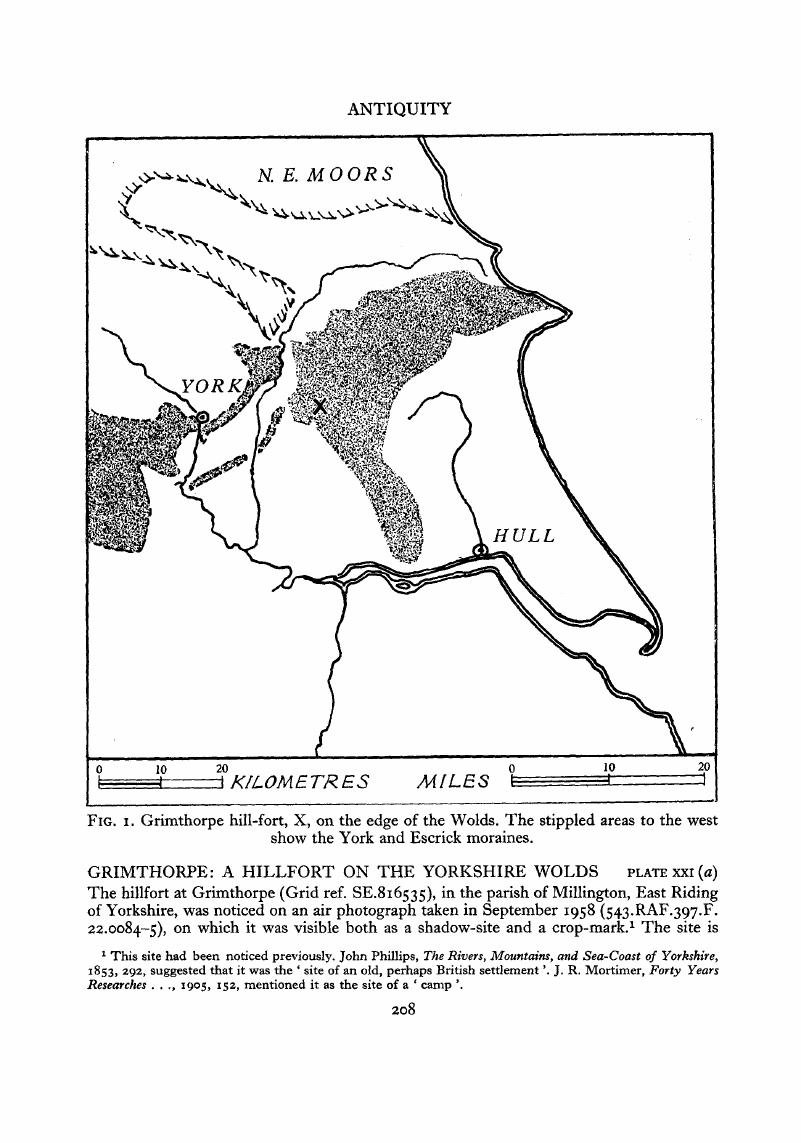Article contents
Grimthorpe: A Hillfort on the Yorkshire Wolds
Published online by Cambridge University Press: 02 January 2015
Abstract

- Type
- Notes and News
- Information
- Copyright
- Copyright © Antiquity Publications Ltd 1959
References
1 This site had been noticed previously. John Phillips, The Rivers, Mountains, and Sea-Coast of Yorkshire, 1853, 292, suggested that it was the ‘site of an old, perhaps British settlement’. J. R. Mortimer, Forty Years Researches . . ., 1905, 152, mentioned it as the site of a ‘camp’.
2 Our thanks are due to Mr C. Cawood, of Grimthorpe Manor, for permission to excavate; to the Prehistoric Research Section of the Yorkshire Archaeological Society for a grant of £25 towards the cost of the excavation; to the Inspectorate of Ancient Monuments, Ministry of Works, for the loan of tools; and to the Royal Commission on Historical Monuments (England) for facilities offered and permission to publish information gathered in the course of official investigations.
3 It appears that the substantial lynchet which almost encircles the hill, and which led to the discovery of the site on the air-photograph, is mainly this chalk outcrop, and only partly the remains of defences. On the north side of the site the ditch and rampart appear, from the air-photograph, to leave the line of the outcrop and pursue their own course slightly downslope.
4 J. R. Mortimer, op. cit., 1905, 152. Mortimer casually refers to the hillfort in his account of a search for burials: ‘On August 20th, 1871, and the following days, we carefully searched the ground on the north, east, and west sides of the pit, over a considerable area, by making trenches about three feet apart; but only found pot sherds, and numerous pieces of animal bone, which did not seem to be connected with burials, but were mixed in the soil, more or less everywhere, and chiefly in the filled up inner ditch of a supposed camp ; the south-west corner of which the chalk-pit occupies’.
5 J. R. Mortimer, op. cit., 1905, 150-2, and The Reliquary, ix, 1868-9, 180-2.
6 The gravegroup is illustrated, J. R. Mortimer, op. cit., 1905, Frontispiece; cf. also S. Piggott, P.P.S., xvi, 1950, 12-13; and Sir Cyril Fox, Pattern and Purpose, 1958, 33-5. With regard to the disc-brooch, Hemp suggested that this object was part of the shield decoration, and in his reconstruction of the shield (W. J. Hemp, Arch. Camb., 7 ser., viii, 1928, 278, fig. 11) he balanced it with a similar disc which is purely hypothetical. The position of the object in the grave (together with two studs it was found ‘about the chest and shoulders’) shows that it could not have belonged to the end of the shield, whose boss was found alongside it. On the other hand it was in a reasonable position for a brooch. As a disc-brooch it is similar to the two from the contemporary sword-burial at Bugthorpe, both of which, like the Grimthorpe specimen, have lost the brooch attachment and are now merely discs, although one of them was recognizable as a fibula when originally found (J. Thurnam, Arch., xl, 1871, 475). Complete examples of this type are illustrated by P. Jacobsthal, Early Celtic Art, 1944, Nos. 348a and 349.
7 John Phillips, 1853, loc. cit.
8 Corder and Richmond (J.B.A.A., 3rd series, vii, 1942, 19) have argued in favour of four tribal centres for the Parisi, one of which they suggest may have been at Millington, which they identify with the Delgovicia of the Antonine Itinerary. They suggest that the four tribal centres were a pre-Roman institution, but there is no evidence for pre-Roman occupation at Millington. On the other hand, the nearby hill-fort at Grimthorpe is the only pre-Roman settlement of any size which might reasonably be assigned to the Parisi, so it would fit in very well as one of their vici. The absence of Roman finds from Grimthorpe would then presumably mean that the centre was moved, perhaps to Millington. But this is all very hypothetical; there is no real evidence that the small site at Millington was a vicus, nor that Grimthorpe, Millington, nor even Delgovicia were Parisian sites.
- 2
- Cited by




